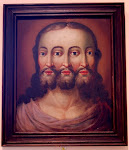On The Fringes of The Bizarre
This video shows a penitential tradition popular in the province of Pampanga in the northern Philippines. The men lying prostrate on the floors are called magdarama; they undertake a multitude of harsh practices of mortification come Holy Week, not the least of which is flagellation. A variant of this practice involves donning a crimson or black robe with a hood covering the face; depending on the penitent, he may use foliage, barbed wire, or even wood for his crown of thorns. A practice which I believe has an equivalent in Mexico is the placing of the patibulum or cross beam made of thorny wood (or just really heavy logs) on the shoulders of the penitent, whose wrists are then chained so as to prevent him from resting. The variant above has the penitents lying face down whilst their accomplices beat them on the backs with plywood (or in this case, a leather belt); afterward, a heavy cross may be placed on the penitent's back for a certain amount of time; the penitent can then choose to walk with the cross strapped to his back, or make his way to a shrine or church on his knees. Off screen, I presume a local family is holding a pabasa, or the chanting of the Lord's passion in verse. It is one of the most enduring and most popular devotions come Holy Week, reaching a peak on Maundy Thursday and Good Friday.
I once heard a professor of mine remark, 'If you were to ask me, I don't really think there's such a thing as Catholicism. But there is a Church, and it's a very real, very powerful thing.' I didn't really understand what he meant when he said that, until I was face to face with the 'real' Catholicism-- that wonderfully mystical, irreducibly inconvenient thing-- that was practiced in the rural areas of the Philippines. When we had our pasiyam (special prayers for the deceased held nine days after death)for my grandmother after she died, and again on her 30th and 40th day commemorations, I remember this old lady, a friend of hers in life and well-known as an intensely religious woman(and not to mention, an incredible mahjong player)who would pause every now and then and instruct my aunts to cover their heads at certain parts in the prayer. She also maintained that the 'Bendita sea Tu pureza' must be prayed three times after that, and a bevy of other details too entangled in the haze of memory to recall right now.
I still don't understand the logic behind it, but I am through arguing with that unstoppable force of tradition now. I'm sure it is animated by the same conviction that requires that the rosary beads clasped by the deceased be severed first before she is finally laid to rest, at the risk of prolonging her purgatory till the end of days. And I am pretty sure it is the same logic that lies behind the belief that stopping one's prayers before the candle blows out is sure to bring bad luck for generations to come. But that is just the problem with faith today-- too many saints, and not enough santos to work their miracles.


















